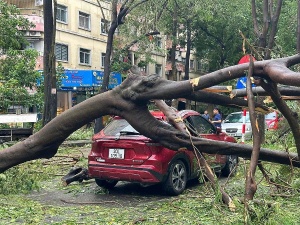Preliminary reports from major insurers show that hundreds of vehicles were damaged due to flooding, hydrolock, or falling objects, with estimated compensation costs reaching into millions off US dollars.
According to damage data from Typhoon Bualoi as of October 1, Hanoi-based DBV Insurance had recorded 226 claims, of which more than 200 involved motor vehicles.
The primary causes were flooding, accounting for 73 per cent of total cases, and falling objects, making up 27 per cent. In some severe cases, the estimated payout for a single vehicle was approximated $28,000.
 |
| The scene of a PTI customer’s car submerged in floodwater caused by Typhoon Bualoi |
During the same period, Post and Telecommunication Insurance Corporation (PTI) reported 156 initial claims via its hotline, including 21 property losses and 135 motor vehicle-related cases.
The main causes were falling trees, flooded vehicles, and damage from flying or falling debris. These incidents were concentrated in areas severely affected by the storm, particularly Hanoi and the north-central region.
On a larger scale, Saigon-Hanoi Insurance (BSH Insurance) recorded 407 claims, including 384 motor vehicle cases, with a total expected compensation of about $560,000.
Between September 29 and October 1 alone, BSH’s hotline received over 3,000 calls, mostly related to flooded vehicles or emergency rescue requests, highlighting both the widespread impact and the high demand for customer support during natural disasters.
These figures highlight the fact that motor vehicles remain the most heavily affected segment during storms, and also represent the biggest payout pressure for non-life warranties.
One of the key factors driving up compensation costs is hydrolock, severe engine damage caused by water entering the engine.
Although this is a common risk during storm season, not many customers purchase the hydrolock coverage extension in their auto insurance policies.
According to a DBV representative, for customers without the hydrolock add-on, the warranty only covers rescue and towing, interior cleaning, electrical/electronic system repairs, and bodywork repairs.
Engine damage from water ingress is only compensated if the customer has purchased the extended coverage. This creates significant differences in policyholder benefits and may lead to disputes if customers were not clearly advised upfront.
Another practical challenge is that assessing the full extent of damage to flooded vehicles is complex. In many cases, the vehicle must be dismantled, parts replaced, and multiple inspections carried out before all damage is identified.
This prolongs the assessment and repair process. As a result, both DBV and BSH have actively affiliated their garages to prepare repair plans, increase staffing, and streamline procedures to diminish customer waiting times.
As of early October, the combined number of reported claims at just three above warranties, DBV, PTI, and BSH, had already nearly reached 800 cases, with estimated total payouts in the range of several millions US dollars.
The actual figure is likely much higher when including other insurance companies. This creates significant short-term financial and liquidity pressure for Vietnam’s non-life insurance sector.
Natural disasters continue to be a key test of the insurance industry’s credibility. Fast and transparent claims processing not only strengthens customer trust but also helps insurers retain policyholders during contract renewal cycles.
Experience from Typhoon Yagi in late 2024 showed that the spike in flooded vehicles led to increased demand for hydrolock coverage.
This add-on, however, remains far from widely purchased, especially among mainstream car owners and motorbike users. Typhoon Bualoi is expected to further boost customer awareness and interest in expanded insurance products related to natural disaster-related risks.
 |
Insurers juggle with market share shifts and moderate gains
Despite severe economic impacts caused by the health crisis, non-life guarantees continue to manoeuvre through the turmoil. |
 |
Insurers’ 2024 profit targets indicate caution
PetroVietnam Insurance Corporation (PVI) passed an ambitious revenue target of $725 million for 2024 at its AGM on March 21, a record figure representing an 8.17 per cent increase on-year. |
 |
Insurers address claims following typhoon Yagi
In the wake of Typhoon Yagil, insurance companies in Vietnam are processing claims related to property damage and loss of life, while coordinating with authorities to expedite compensation and ensure a swift recovery for affected customers. |





